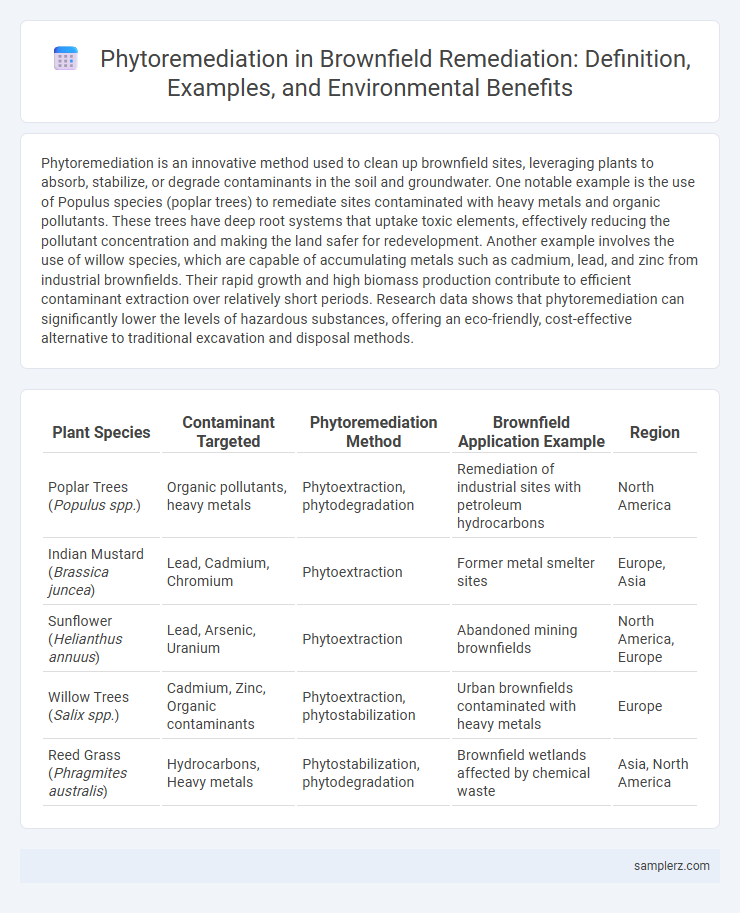Phytoremediation is an innovative method used to clean up brownfield sites, leveraging plants to absorb, stabilize, or degrade contaminants in the soil and groundwater. One notable example is the use of Populus species (poplar trees) to remediate sites contaminated with heavy metals and organic pollutants. These trees have deep root systems that uptake toxic elements, effectively reducing the pollutant concentration and making the land safer for redevelopment. Another example involves the use of willow species, which are capable of accumulating metals such as cadmium, lead, and zinc from industrial brownfields. Their rapid growth and high biomass production contribute to efficient contaminant extraction over relatively short periods. Research data shows that phytoremediation can significantly lower the levels of hazardous substances, offering an eco-friendly, cost-effective alternative to traditional excavation and disposal methods.
Table of Comparison
| Plant Species | Contaminant Targeted | Phytoremediation Method | Brownfield Application Example | Region |
|---|---|---|---|---|
| Poplar Trees (Populus spp.) | Organic pollutants, heavy metals | Phytoextraction, phytodegradation | Remediation of industrial sites with petroleum hydrocarbons | North America |
| Indian Mustard (Brassica juncea) | Lead, Cadmium, Chromium | Phytoextraction | Former metal smelter sites | Europe, Asia |
| Sunflower (Helianthus annuus) | Lead, Arsenic, Uranium | Phytoextraction | Abandoned mining brownfields | North America, Europe |
| Willow Trees (Salix spp.) | Cadmium, Zinc, Organic contaminants | Phytoextraction, phytostabilization | Urban brownfields contaminated with heavy metals | Europe |
| Reed Grass (Phragmites australis) | Hydrocarbons, Heavy metals | Phytostabilization, phytodegradation | Brownfield wetlands affected by chemical waste | Asia, North America |
Introduction to Phytoremediation in Brownfields
Phytoremediation harnesses plants like hybrid poplar trees and Indian mustard to extract, stabilize, or degrade contaminants such as heavy metals and organic pollutants in brownfield sites. This eco-friendly remediation method reduces soil toxicity and restores ecosystem functions without the need for invasive excavation or chemical treatments. Successful applications in urban brownfields demonstrate cost-effective cleanup while promoting biodiversity and soil health recovery.
Common Types of Brownfield Contaminants
Phytoremediation effectively addresses common brownfield contaminants such as heavy metals (lead, cadmium, arsenic), petroleum hydrocarbons, and volatile organic compounds (VOCs). Plant species like Indian mustard (Brassica juncea) and poplar trees (Populus spp.) absorb and stabilize these toxic substances, reducing soil and groundwater contamination. This green technology offers a sustainable and cost-effective approach to rehabilitating degraded brownfield sites for safe redevelopment.
Popular Plants Used for Brownfield Phytoremediation
Sunflower (Helianthus annuus) is widely recognized for its ability to extract heavy metals such as lead and arsenic from contaminated brownfields through phytoremediation. Indian mustard (Brassica juncea) effectively accumulates heavy metals like cadmium, chromium, and nickel, making it a popular choice for soil remediation in industrial sites. Poplar trees (Populus spp.) are extensively planted for their rapid growth and high transpiration rates, which enhance the removal of organic pollutants and heavy metals in degraded brownfield environments.
Case Study: Sunflowers for Heavy Metal Removal
Sunflowers have been effectively used in brownfield phytoremediation to extract heavy metals such as lead and arsenic from contaminated soils, demonstrating significant reductions in pollutant concentrations. In a case study at a former industrial site, sunflower plants absorbed and accumulated toxic metals through their roots, improving soil quality and enabling safer land reuse. This method offers an eco-friendly, cost-effective approach to rehabilitating heavily polluted brownfields without disruptive excavation.
Willow Trees in Groundwater Remediation
Willow trees are highly effective in phytoremediation of brownfield sites due to their deep root systems and rapid growth, which enable the uptake and breakdown of pollutants in groundwater. These trees absorb heavy metals and organic contaminants, transforming them into less harmful compounds through metabolic processes. Their use in contaminated groundwater remediation reduces toxic substances and restores ecological balance, making them a sustainable solution for brownfield rehabilitation.
Grasses for Hydrocarbon Contamination Cleanup
Grasses such as Vetiver (Chrysopogon zizanioides) and Bermuda grass (Cynodon dactylon) effectively stabilize and degrade hydrocarbon contaminants in brownfield sites through phytoremediation. These grasses enhance microbial activity in the rhizosphere, accelerating the breakdown of petroleum hydrocarbons and reducing soil toxicity. Their extensive root systems improve soil structure and facilitate contaminant uptake, making them ideal for restoring urban brownfields impacted by hydrocarbon pollution.
Poplar Trees in Detoxification of Polluted Soils
Poplar trees are highly effective in phytoremediation of brownfield sites due to their rapid growth and deep root systems that absorb heavy metals and organic pollutants from contaminated soils. Their ability to uptake and metabolize toxic substances like lead, cadmium, and petroleum hydrocarbons makes them a preferred choice for detoxifying polluted urban lands. Implementing poplar plantations helps restore soil health, reduces environmental risks, and supports ecological recovery in degraded industrial areas.
Advantages of Phytoremediation over Traditional Methods
Phytoremediation of brownfields using plants like sunflowers and willows offers significant advantages such as cost-effectiveness and minimal environmental disruption compared to traditional methods like soil excavation and chemical treatments. This green technology enhances soil health by promoting microbial activity and stabilizes contaminants, reducing the risk of leaching. Its sustainability and ability to remediate large areas with less energy input make it a preferential choice for restoring contaminated industrial sites.
Challenges and Limitations in Brownfield Phytoremediation
Phytoremediation of brownfields faces challenges such as heterogeneous contamination, which complicates plant uptake and contaminant degradation. Soil toxicity and low nutrient availability limit the growth and effectiveness of hyperaccumulator species. Furthermore, long remediation timeframes and potential bioaccumulation risks restrict the practical application of phytoremediation on large-scale brownfield sites.
Future Prospects of Phytoremediation in Urban Redevelopment
Phytoremediation offers promising future prospects in urban redevelopment by efficiently detoxifying brownfield sites through plants such as poplars, willows, and sunflowers, known for their ability to absorb heavy metals and organic pollutants. Integrating this green technology with smart urban planning supports sustainable land reuse while minimizing environmental and health risks. Ongoing research on genetically engineered hyperaccumulators and microbial symbiosis aims to enhance remediation speed and effectiveness, further boosting phytoremediation's viability in densely populated urban settings.

example of phytoremediation in brownfield Infographic
 samplerz.com
samplerz.com